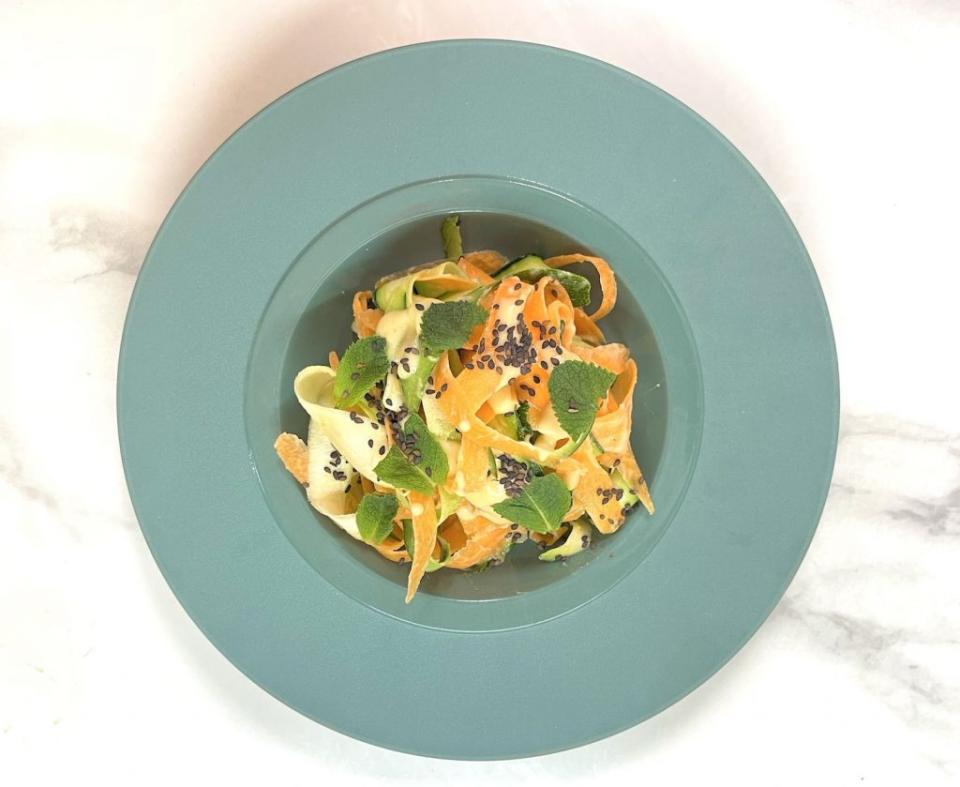Fiber 101: Why and how you should increase your fiber intake — plus, a delicious rice bowl recipe!

Adriana Urbina is an In The Know cooking contributor. Follow her on Instagram and visit her website for more.
When it comes to maintaining good health, there’s nothing more important than having a healthy gut. Taking care of your gut will not only make you feel more energetic and focused, but it will also help to boost your immunity, clear your skin, improve your overall mood and more.
So, what’s the key to unlocking good gut health?
First, understand what foods will help keep your microbiome healthy, which stems from also understanding your own individual bio and what works best for you. Doing this can usually be as simple as listening to what your body tells you after you eat certain foods. If you feel bloated, dizzy or lack energy after eating something, write that down in a food diary and find ways to reduce your consumption of that ingredient or replace it with other delicious foods.
It’s also helpful to get educated — specifically about fiber and its function for your body. Luckily, I’m here to do just that for you!
There are two types of fiber found in foods: dietary and functional.
Dietary fiber is naturally found in plants. There are two classes of dietary fiber — insoluble and soluble — and you should know the difference because they offer different health benefits.
Insoluble fiber doesn’t dissolve in water and is found in foods like vegetables and whole grains. Soluble fiber, found in foods like oats and beans, swells in water. It also works to lower blood cholesterol and support blood sugar levels.
Most plant foods contain both insoluble and soluble fiber, and it’s the proportion and location of each class of fiber that differs. For example, pears have a higher percentage of insoluble fiber than soluble fiber. Meanwhile, potato skin is higher in insoluble fiber, but the flesh of the potato is typically higher in soluble fiber.
Common sources of insoluble fiber include brown rice, nuts, pears, popcorn, strawberries, wheat bran, whole grain cereals, whole-wheat flour and zucchini (and other vegetables with edible skins).
Common sources of soluble fiber include apples, barley, beans, citrus fruits, dates, jicama, leeks and oatmeal.
The good news is that there are a few simple shifts you can make to increase your consumption of dietary fiber in your everyday diet:
Refined-grain bread can be swapped with 100% whole-grain bread.
An additional serving of vegetables can be added to meals.
You can create a mixture with flax, hemp and chia seeds and sprinkle it on any meal. This will add texture, vitamins, minerals and more fiber, of course!
If you’re ready to start taking good care of your gut health, here is one of my favorite fiber-packed summer salads. Enjoy!
Crunchy Vegetable Slaw Bowl with Basmati Rice

Basmati Rice
Yields 4 servings
Ingredients:
1 cup brown basmati rice, rinsed
2 cups water
Pinch of salt
Directions:
Optional: Soak rice in 3 cups of water for up to one day; drain.
Place basmati rice in pot with 2 cups of water and a pinch salt.
Bring to a rolling boil. Cover and reduce heat to lowest setting.
Let cook for 40 minutes, or until done. Don’t stir it while it’s cooking.
Turn the heat off and let rice sit for 5 minutes to finish cooking.
Fluff gently with a fork to separate grains before serving.
Notes:
If you want to vary the taste of your rice, cook it with spices such as cinnamon or cardamom to give it a different flavor.
Crunchy Vegetable Slaw
Prep Time: 5 minutes; do while rice cooks
Yields 4 servings
Slaw ingredients:
5 stalks bok choy (about 1/2 head), thinly sliced
1 carrot, sliced with a peeler
1/2 small red onion, thinly sliced
1 Granny Smith apple, sliced
1/2 cup alfalfa sprouts (optional)
Dressing ingredients:
1 teaspoon ground coriander
1 teaspoon dijon mustard
2 tablespoons apple cider vinegar (or lemon juice)
1/4 cup olive oil
2 teaspoons honey or brown rice syrup salt and black pepper to taste
1 teaspoon toasted sesame seeds (optional)
Directions:
In a bowl, toss the bok choy, onion, carrot, apple and sprouts.
In a separate bowl, mix the dressing ingredients.
Pour the desired amount of dressing over the vegetable mixture and mix.
Notes:
Serving suggestion: Serve ½ cup of basmati rice and top it off with the vegetable slaw, all at room temperature
If not eating immediately, let it chill for up to an hour and then add the apples just before eating.
Variations you can try: Use cabbage instead of bok choy and carrot slices instead of onions.
Add fresh herbs like cilantro, parsley, mint or scallions to amp up the flavors.
Double the dressing ingredients and use leftover grains or rice later in the week.
If you enjoyed this story, check out Adriana Urbina’s tips for keeping cool with your eating this summer!
The post Fiber 101: Why and how you should increase your fiber intake — plus, a delicious rice bowl recipe! appeared first on In The Know.

 Yahoo Finance
Yahoo Finance 